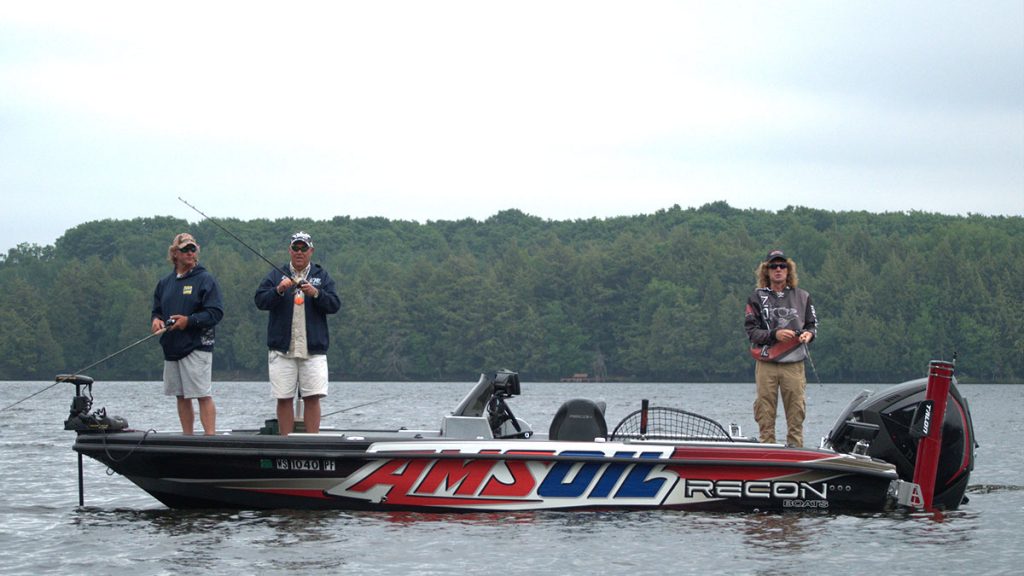For maximum performance and service life, make sure to winterize your boat and outboard motor at the end of the season each year. If you take these steps, you’ll help ensure your boat and motor will be ready to hit the water again the following spring.
How to Winterize a Boat and Outboard Motor
Total Time: 1 hour and 30 minutes
Change lower-unit gear lube
It’s critical to change gear lube prior to storage to remove any water so it doesn’t freeze, causing damage, or hasten rust on gears and bearings, shortening component life. u003cbr/u003eu003cbr/u003eWith the motor level, remove the oil drain plug and open the upper-level plug, which is usually on the side of the motor. While the oil is draining, look for any contaminants such as water or metal particles. For reduced mess and hassle, use the u003ca href=u0022https://www.amsoil.com/p/amsoil-synthetic-marine-gear-lube-75w-90-agm/?code=AGMPK-EAu0022u003eAMSOIL Synthetic Marine Gear Lube easy packu003c/au003e, which eliminates the need for a gear-lube pump. Refill the unit with fresh oil until it starts to come out of the top plug. Then, reinsert the top plug and then the lower plug.u003cbr/u003eu003cbr/u003eu003cimg alt=u0022Change outboard motor gear lubeu0022 src=u0022https://blog.amsoil.com/wp-content/uploads/2016/11/Change_Lower_Unit_Gear_Lube_300px.jpgu0022/u003e
Change motor oil
You can obviously skip this step for a two-stroke motor. Just ensure the reservoir is full.u003cbr/u003eu003cbr/u003eIn a four-stroke, change the oil and filter prior to storage so contaminants that have accumulated in the oil aren’t sitting in the engine all winter. Simply remove the drain plug and drain out the old oil. Remove the filter, too. u003ca href=u0022https://blog.amsoil.com/what-should-i-do-with-used-motor-oil/u0022u003eMake sure to dispose of them properlyu003c/au003e. Wipe the filter mount clean and install a new filter, making sure to apply a thin coat of clean oil to the gasket. Reinstall the drain plug and top-off the engine. u003cbr/u003eu003cbr/u003eu003cimg alt=u0022Change outboard motor oilu0022 src=u0022https://blog.amsoil.com/wp-content/uploads/2016/11/Drain_Outboard_Motor_Oil_300px.jpgu0022/u003e
Stabilize the gas
Gasoline can degrade in as few as 30 days. When fuel degrades, it can lead to corrosion and deposits in your tank. Add u003ca href=u0022https://www.amsoil.com/p/gasoline-stabilizer-ast/?code=ASTCN-EAu0022u003egasoline stabilizeru003c/au003e to the gas tank and run the engine for a couple minutes to distribute stabilized fuel throughout the system. This eliminates the need to drain the fuel system prior to storage.u003cbr/u003eu003cbr/u003eu003ca href=u0022https://amsoilcontent.com/ams/ShopRes/products/900px/Stabilizer_Corrosion.jpgu0022u003eu003cimg alt=u0022Stabilize gas before storageu0022 src=u0022https://blog.amsoil.com/wp-content/uploads/2019/10/AST_Sea_Foam_500px.gifu0022 style=u0022width: 300px;u0022/u003eu003c/au003e
Fog the engine
Fogging the engine applies a coating of oil to the cylinders, pistons, rings and other components in the upper end. This helps prevent rust formation during storage. In most cases, you need to run the motor while fogging it. But, some newer motors are equipped with automated systems that fog the motor for you. Check your owner’s manual for details about your specific motor.
Grease tilt tube and other areas
Rust can form on the tilt tube and restrict movement when raising or lowering the motor. Apply a u003ca href=u0022https://www.amsoil.com/p/synthetic-water-resistant-grease-gwr/u0022u003ewater-resistant greaseu003c/au003e to the tilt tube, trailer bearings and other grease fittings to help displace moisture and guard against rust formation.
Blow out water
Water in the live wells, bilge or bilge pump should be blown out with compressed air so it doesn’t freeze. It’s a good idea to leave the drain plug out during storage. u003cbr/u003eu003cbr/u003eu003cimg alt=u0022Blow out water from boat live wellu0022 src=u0022https://blog.amsoil.com/wp-content/uploads/2016/11/Live_Well_Boat_300px.jpgu0022/u003e
Store the battery
Be sure to charge and disconnect the battery. If your boat won’t be in a climate-controlled environment, it’s best practice to remove the battery and store it in your basement or other climate-controlled environment.
Clean and cover your boat
Finally, give your boat a good cleaning. While you’re at it, inspect the hull, floor, seats and other areas for wear and tear that require attention. Now’s the time to get it done before marinas are inundated with work in the spring. u003cbr/u003eu003cbr/u003eCover your boat with a high-quality cover or shrink wrap and store it in a safe place for the winter.
Updated. Originally published Nov. 2, 2016.
